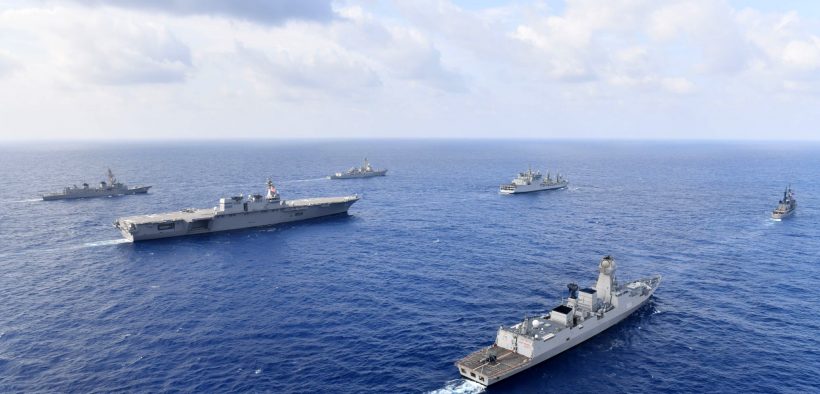US Conducts Joint Maritime Drill Amid Rising Tension in the South China Sea

Amid a trade war with China, the U.S. has conducted its first joint military exercise with ASEAN nations in the coveted South China Sea.
On Monday, Sept. 2, the U.S. and 10 ASEAN member countries held their first joint military training exercise just a year after the same ten country bloc held similar drills with China in late 2018. The U.S. and Chinese drills exemplify how both nations are vying for power and influence in the Southeast Asian region.
For its part, ASEAN (Association of Southeast Asian Nations) likely sees the joint military training with the U.S. as an effort to be a balancing act amid the worsening tension between the U.S. and China but is also likely trying to benefit from the situation.
Before the military exercise with the U.S., the 10-country bloc which includes Indonesia, Vietnam and the Philippines held naval exercises with China in the disputed South China Sea in October 2018. The exercises were held despite China’s regional disputes with other claimants in the bloc (Brunei, Vietnam, Malaysia and the Philippines).
The U.S. naval maritime drill kicked off in Thailand on Monday and will conclude in Singapore this weekend (Sept. 7-8). The exercises included eight warships, four jets and more than 1,000 personnel.
Rear Admiral Joey Tynch, who is supervising the military training, said that the purpose of the joint maritime drill is to establish more regional security.
“AUMX builds greater maritime security on the strength of ASEAN, the strength of our navy-to-navy bonds, and the strength of our shared belief in a free and open Indo-Pacific,” said Tynch in a statement from the U.S. embassy in Thailand.
Tensions Are Still High in the South China Sea
The joint exercise is being carried out amid recent disputes involving China and Vietnam. This past July, a Chinese gas survey ship named Haiyang Dizhi accompanied by naval ships entered Vietnam’s Exclusive Economic Zone (EEZ) to conduct a seismic survey, though China claims the area entered is part of China’s EEZ. Hanoi saw such an act as a violation of its territory, triggering a stand-off between the two countries.
China’s move came after Vietnam granted Russian state-owned company Rosneft rights to explore for oil in the disputed EEZ called the Vanguard Bank which sits 200 miles offshore from Vietnam.
Despite a 2016 verdict by the Hague-based Permanent Court of Arbitration which rejected China’s claims to over 90% of the South China Sea, China has built seven artificial islands equipped with monitoring posts in the South China Sea.
Three years before the court’s ruling, the Philippines filed a legal protest that China’s territorial claims based on the vague and controversial demarcation line called the “Nine-Dash-Line” violated Manila’s territorial sovereignty and the universally accepted international law, the United Nations Convention on the Law of the Sea (UNCLOS). The sea convention stipulates all maritime states must have a 200-nautical mile EEZ as well as a 12-nautical mile territorial sea or continental shelf. The pact also bans the use of military power to solve maritime disputes.
The South China Sea is highly disputed and sought after due to its strategic location surrounding 10 countries including Vietnam, Cambodia, Indonesia, China, Taiwan, Malaysia, Thailand, Singapore, Brunei and the Philippines plus it has an abundance of natural resources. The sea contributes 10% of global fish needs and data suggests that the South China Sea contains 11 billion barrels of oil reserves and 190 trillion cubic feet of natural gas.
South China Sea’s Code of Conduct as a Non-Military Solution
Indonesia’s Foreign Ministry stated on August 1 that ASEAN members and China had finished the first reading of the Code of Conduct (COC) on the South China Sea. ASEAN and China first agreed to establish a set of norms and proper practices for conduct in the South China Sea back in 2002. It is hoped that finalizing the agreement will help reduce tension in the area.
“It marks new, major progress in the COC consultations and an important step toward the goal of concluding the consultations within three years’ time,” said a Chinese top diplomat.
However, China and ASEAN may face stumbling blocks in reaching a mutual consensus regarding ethic codes and regulations. China wants the COC to be non-legally binding to boost regional trust, while ASEAN wants the code of conduct to help eliminate overlapping legal claims.
China and ASEAN issued the Declaration on Conduct of the Parties on the South China Sea (DOC) signed in Phnom Penh, Cambodia, in 2002. The document contained commitments from ASEAN member countries and China to comply with international law principles, respecting freedom of navigation in the South China Sea, resolving disputes peacefully and restraining from conducting an act that triggers an international clash.
Despite pressuring smaller countries against their wishes, China is one of the most important partners to ASEAN. Therefore, ASEAN countries are working hard to find common ground to solve the tension in one of the world’s most strategic waterways and to make sure that China is cooperative in defusing conflicts in the crucial territory.









